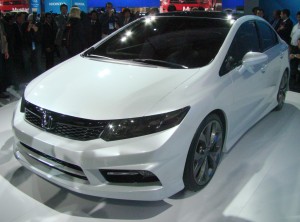When automakers begin releasing their sales numbers later today the industry could be in for some good news, April new car, truck and crossover sales expected to show a 19% overall gain despite concerns about rising gas prices and an uncertain economy.
But for consumers, the April sales held some disappointment, nonetheless, industry analysts say, with prices rising and incentives falling as the March 11 disaster in Japan began to curb the availability of Asian-made products.
Indeed, some observers warn that April could be the end of the steady stream of improving sales numbers due to those shortages. Honda, for one, yesterday warned dealers that it will be unable to keep up with demand for the new Honda Civic, while both Honda and Toyota have decided to delay the launches of several important new products in the months ahead.
Ironically, the impact could be most severe when it comes to the products gaining most in popularity as fuel prices soar towards new record levels. Not only is Honda warning it will be short of Civic sedans and coupes, but the maker will have trouble meeting demand for its various hybrid models, such as the CR-Z and Insight, which are imported from Japan.
Toyota will be short of its subcompact Yaris, also produced in Japan. And the maker has now delayed the upcoming introductions of the Scion iQ microcar as well as the Prius V, a larger model sharing the Prius name with the current hybrid best-seller.
As supplies of many Japanese models have dwindled, dealers have been pushing up prices. Combined with reduced factory incentives, that led to a noticeable bump in average transaction prices in April, according to the data service TrueCar.com.
The firm’s senior analyst, Jesse Toprak, noted that “high gas prices cause(d) near record-level purchases of fuel-efficient vehicles in April. Yet despite a shift to smaller, typically less expensive offerings, the ATP – what buyers actually pay for their vehicle – reached $29,853 last month. Tellingly, that was $305, or 1.0%, higher than in March.
Industry-wide, incentives declined by 4% from March to April, as supplies fell, but tellingly, both Toyota and Honda reduced their consumer givebacks by 17%.
TrueCar also noted that based on its dealer-supplied data, the average new vehicle sold in April was a mile per gallon more fuel-efficient than the year before.
“One mile per gallon improvement may seem insignificant at first glance,” said Toprak, “but if 13 million vehicles are sold annually in the U.S., this translates into a reduction in fuel consumption of 416 million gallons or savings of about $1.6 billion every year.”
The shortage of Japanese made auto parts is impacting virtually every automaker, noted Honda’s U.S. chief executive John Mendel. Even General Motors has had to temporarily idle plants in the U.S. and Europe, and Chrysler CEO Sergio Marchionne said, this week, that the American maker might lose as much as 100,000 units of production, in 2011, because of supply problems.
Nonetheless, the biggest impact is likely to be felt by Japanese brands, especially those, like Toyota, that still import a sizable number of vehicles from home market plants.
April sales numbers could reveal whether that is beginning to lead buyers to shift from Japanese to U.S., European or Korean brands, something analyst Art Spinella, of CNW Marketing, expects will happen at an accelerated pace in the coming months.
American makers, in particular, hope to take advantage of the situation, having begun to roll out a variety of smaller and hybrid models, like Ford’s new Focus, targeting segments long dominated by the Japanese.

